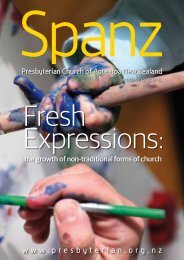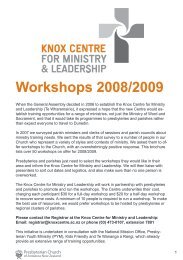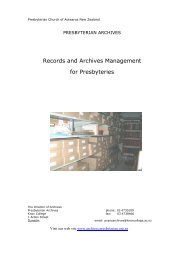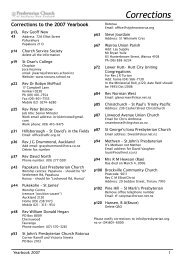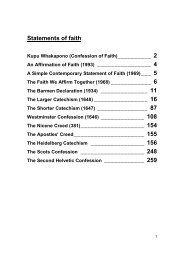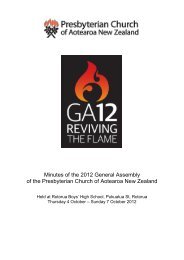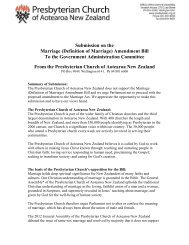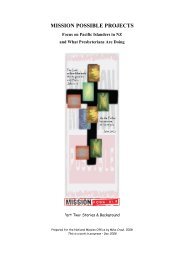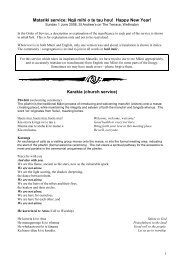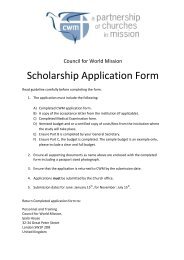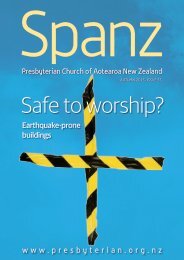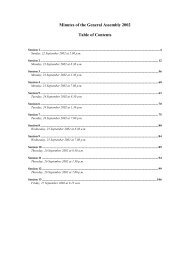Cultural diversity and unity in Christ: the Presbyterian Church of ...
Cultural diversity and unity in Christ: the Presbyterian Church of ...
Cultural diversity and unity in Christ: the Presbyterian Church of ...
Create successful ePaper yourself
Turn your PDF publications into a flip-book with our unique Google optimized e-Paper software.
former have <strong>in</strong>creas<strong>in</strong>gly wanted to adjust to wider NZ cultural ways <strong>of</strong> do<strong>in</strong>g th<strong>in</strong>gs, but also become<br />
<strong>in</strong>creas<strong>in</strong>gly <strong>in</strong>volved <strong>in</strong> multicultural or multiethnic sett<strong>in</strong>gs. In light <strong>of</strong> this it is <strong>in</strong>terest<strong>in</strong>g to note<br />
that Leuatea Sio, a significant leader <strong>in</strong> <strong>the</strong> Pacific Isl<strong>and</strong> churches, stated that “God had brought<br />
Pacific Isl<strong>and</strong> members to <strong>the</strong> <strong>Presbyterian</strong> family <strong>in</strong> order for us to learn new ways <strong>of</strong> be<strong>in</strong>g a church<br />
<strong>in</strong> our new home”, a laudable vision that has at times been difficult for some to flesh out.<br />
At a national level some <strong>of</strong> <strong>the</strong> more established leaders, dissatisfied with what <strong>the</strong>y see as a lack <strong>of</strong><br />
recognition <strong>of</strong> Pacific Isl<strong>and</strong> cultural concerns <strong>and</strong> practices by <strong>the</strong> wider church, <strong>and</strong> see<strong>in</strong>g<br />
<strong>in</strong>creas<strong>in</strong>g <strong>in</strong>tegration as be<strong>in</strong>g simply assimilation <strong>in</strong>to a ‘palagi’(<strong>the</strong> Samoan word for Europeans)<br />
church <strong>in</strong> which <strong>the</strong>y have little power <strong>and</strong> fear los<strong>in</strong>g <strong>the</strong>ir identity, all concerns which have<br />
considerable validity, have at times wanted to set a separate Pacific Isl<strong>and</strong> structure. In 1992 <strong>the</strong>re was<br />
a move to restructure <strong>the</strong> church <strong>in</strong>to three equal partnerships, Maori, Pakeha <strong>and</strong> Pacific (with <strong>the</strong><br />
possibility <strong>of</strong> a fourth be<strong>in</strong>g added, Asian). This was modelled on <strong>the</strong> structure which <strong>the</strong> Anglican<br />
<strong>Church</strong> <strong>in</strong> NZ with a Tikanga Pakeha, Tikanga Maori <strong>and</strong> Tikanga Pasefika, each hav<strong>in</strong>g <strong>the</strong> power <strong>of</strong><br />
veto mak<strong>in</strong>g cooperation <strong>and</strong> <strong>unity</strong> very difficult 14 . Observ<strong>in</strong>g from outside <strong>of</strong> that church, <strong>and</strong> with<br />
<strong>the</strong> benefit <strong>of</strong> h<strong>in</strong>dsight, it seems providential that this step was not followed. For <strong>the</strong> PCANZ this<br />
issue has also been fuelled by historic roots <strong>of</strong> <strong>the</strong> Pacifica <strong>Church</strong>es <strong>in</strong> <strong>the</strong> Congregational ra<strong>the</strong>r than<br />
<strong>Presbyterian</strong> <strong>Church</strong>, with its somewhat more diffuse polity as well some sense <strong>of</strong> still be<strong>in</strong>g<br />
newcomers ra<strong>the</strong>r than part <strong>of</strong> <strong>the</strong> establishment. 15 In 1997 a Pacific Isl<strong>and</strong> Synod was set up, but with<br />
limited powers.<br />
It is necessary to add at this po<strong>in</strong>t that this concern for reta<strong>in</strong><strong>in</strong>g a dist<strong>in</strong>ct ethno/cultural identity by<br />
separate groups is not just a Pacific Isl<strong>and</strong> dist<strong>in</strong>ct from European issue, although it is that. It is also<br />
an issue <strong>of</strong> Samoan dist<strong>in</strong>ct from Niuean from Tongan from Cook Isl<strong>and</strong> from Tokelauan. Many <strong>of</strong><br />
<strong>the</strong> Pacific Isl<strong>and</strong> churches are for a s<strong>in</strong>gle isl<strong>and</strong> group <strong>and</strong> some current doctoral research be<strong>in</strong>g<br />
done on this issue with<strong>in</strong> <strong>the</strong> PCANZ <strong>in</strong>dicates that 83% <strong>of</strong> churches are ethnically homogenous,<br />
def<strong>in</strong><strong>in</strong>g ethnicity <strong>in</strong> <strong>the</strong> Pacific context as be<strong>in</strong>g a separate ethnicity for each group. O<strong>the</strong>r Pacifica<br />
churches have several dist<strong>in</strong>ct worshipp<strong>in</strong>g congregations for each group. Endeavours to merge <strong>the</strong>se<br />
have <strong>of</strong>ten met resistance, <strong>and</strong> at <strong>the</strong> heart <strong>of</strong> this has been <strong>the</strong> language issue.<br />
Asians have <strong>the</strong> lowest rate <strong>of</strong> <strong>Christ</strong>ian identity <strong>of</strong> any <strong>of</strong> <strong>the</strong> major groups <strong>in</strong> NZ, at 28%. Signficant<br />
numbers identify with one <strong>of</strong> <strong>the</strong> o<strong>the</strong>r three major world religions, H<strong>in</strong>du, Buddhism or Islam. With<strong>in</strong><br />
this broad group <strong>in</strong> 2006 73% <strong>of</strong> Koreans identified as <strong>Christ</strong>ian, a considerably higher rate than <strong>in</strong><br />
Korea. Of <strong>the</strong>se 30% are <strong>Presbyterian</strong> <strong>and</strong> 22% Catholic. The o<strong>the</strong>r group with a high level <strong>of</strong><br />
<strong>Christ</strong>ian identity are Filip<strong>in</strong>os, with 93%, <strong>and</strong> <strong>of</strong> <strong>the</strong>se 74% are Catholic. Of Ch<strong>in</strong>ese 28% identified<br />
as <strong>Christ</strong>ian with <strong>the</strong> highest number be<strong>in</strong>g <strong>in</strong> Pentecostal, charismatic or Baptist churches. Estimates<br />
are that about 80% <strong>of</strong> <strong>the</strong>se Asians attend an ethnic church, <strong>and</strong> aga<strong>in</strong> as with Pacifica peoples most <strong>of</strong><br />
<strong>the</strong>se are <strong>of</strong> <strong>the</strong> same ethnicity ra<strong>the</strong>r than be<strong>in</strong>g ‘pan-Asian’ 16 . With<strong>in</strong> <strong>the</strong> PCANZ <strong>the</strong> significantly<br />
largest group are Korean, but <strong>the</strong>re are also Taiwanese, Cantonese-Ch<strong>in</strong>ese, M<strong>and</strong>ar<strong>in</strong>-Ch<strong>in</strong>ese,<br />
Indonesian, Filip<strong>in</strong>o <strong>and</strong> Indian congregations. Asians have been <strong>in</strong> NZ for less time than Pacifica<br />
people, but already <strong>the</strong>y are f<strong>in</strong>d<strong>in</strong>g difficulty hold<strong>in</strong>g <strong>the</strong> 1.5 generation, a trend that has been well<br />
identified <strong>in</strong> <strong>the</strong> US where <strong>the</strong>y have been present for a longer time. 17 However it is to be noted that<br />
<strong>the</strong> Asian leadership is show<strong>in</strong>g a greater degree <strong>of</strong> awareness <strong>of</strong> <strong>the</strong> challenge this generational<br />
change provides, <strong>and</strong> a greater will<strong>in</strong>gness to adapt seek to <strong>in</strong>tegrate.<br />
14 ‘Tikanga’ is a Maori word that translates as “correct procedure, custom, habit”. The Anglican Theological<br />
Institution at St John’s <strong>in</strong> Auckl<strong>and</strong> has separate Colleges, one for each Tikanga, <strong>and</strong> has been rent by pa<strong>in</strong>ful<br />
divisions s<strong>in</strong>ce <strong>the</strong> model was adopted. The new Dean <strong>of</strong> <strong>the</strong> Tikanga Pakeha College, com<strong>in</strong>g from overseas,<br />
notes that what she sees is noticeably absent is ‘any language <strong>of</strong> <strong>the</strong> body <strong>of</strong> <strong>Christ</strong>’.<br />
15 Over <strong>the</strong> last decade or so <strong>the</strong>re have also been ‘new’ Congregational <strong>Church</strong>es established, still run from<br />
Samoa or <strong>the</strong> Cook Isl<strong>and</strong>s, complicat<strong>in</strong>g <strong>the</strong> relationship fur<strong>the</strong>r.<br />
16 Pan Asian is a term which is used to cover all <strong>the</strong> various people groups <strong>of</strong> Asia toge<strong>the</strong>r, emphasis<strong>in</strong>g that<br />
despite <strong>the</strong> tendency <strong>of</strong> westerners to describe people as Asian <strong>the</strong>re is <strong>in</strong> fact no ‘Asian’ ethnic group.<br />
17 See eg. Ho-Young Kwon, Kuang Chung Kim, R. Stephen Warner, Korean Americans <strong>and</strong> Their Religions<br />
(Pennsylvania: Pennsylvania State University Press, 2001).<br />
7



